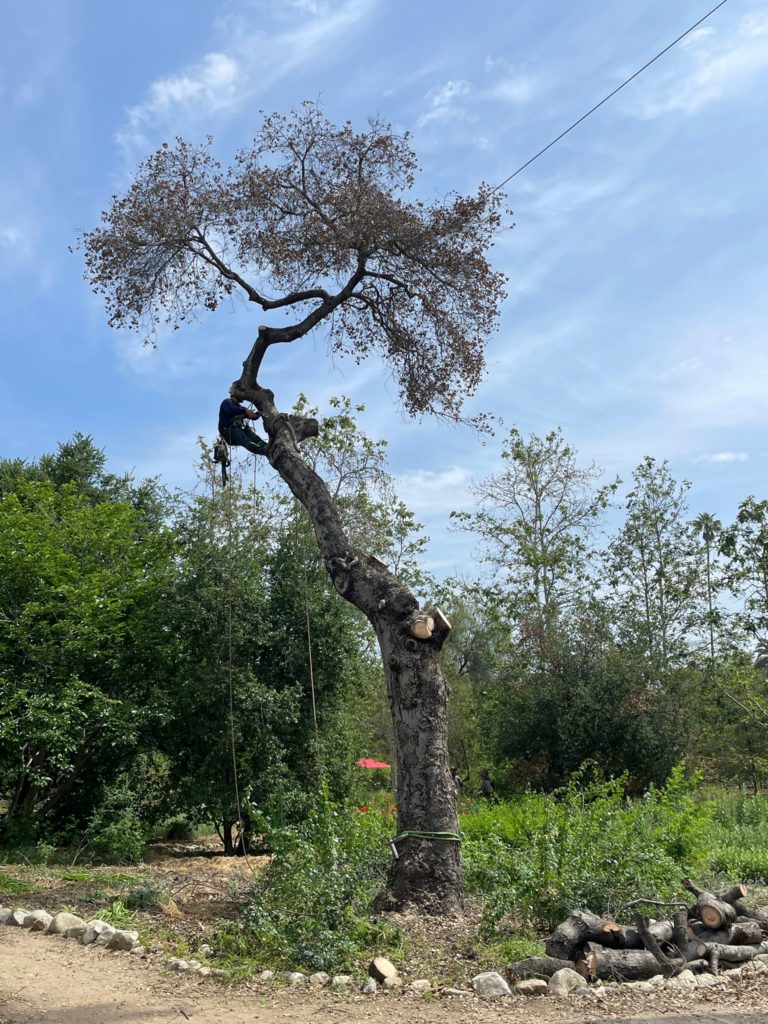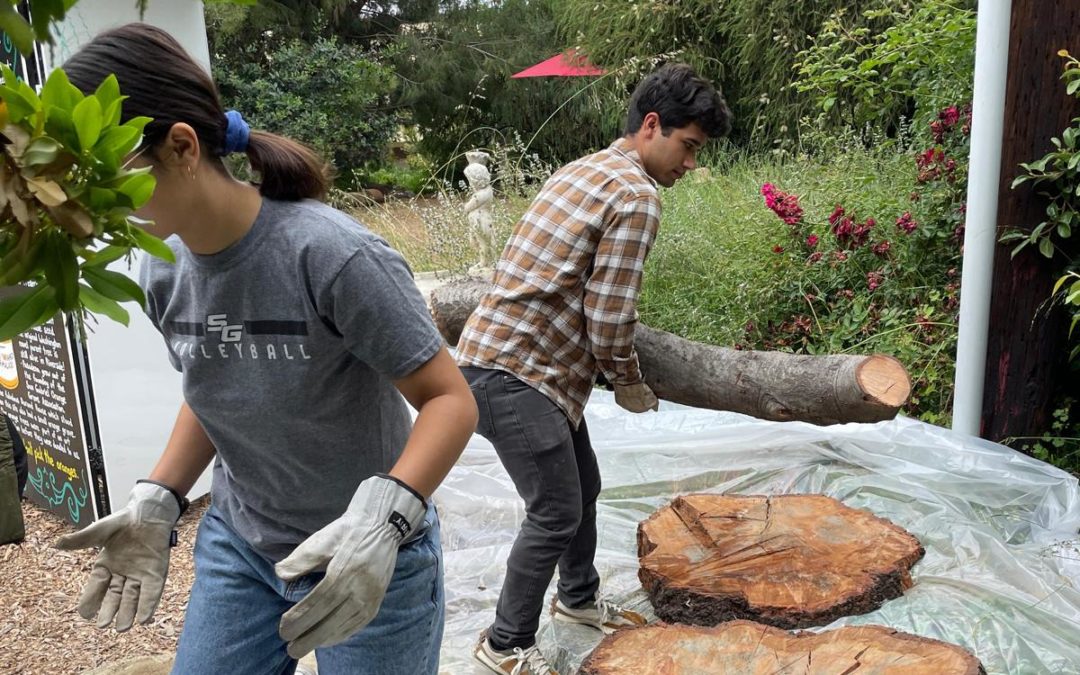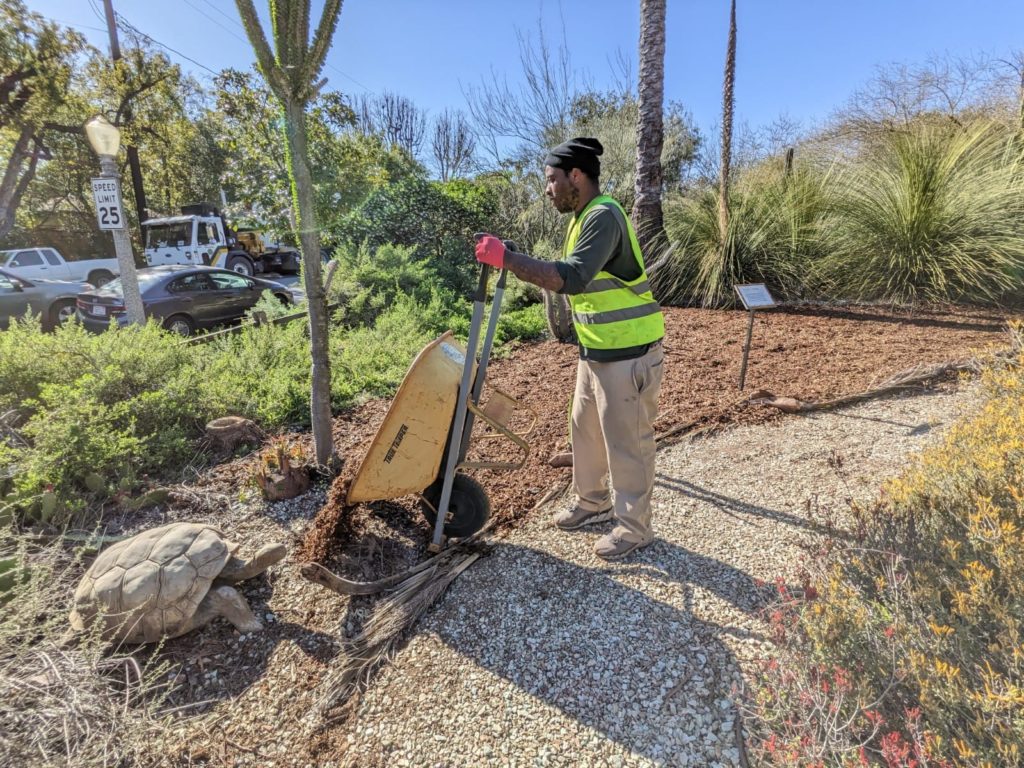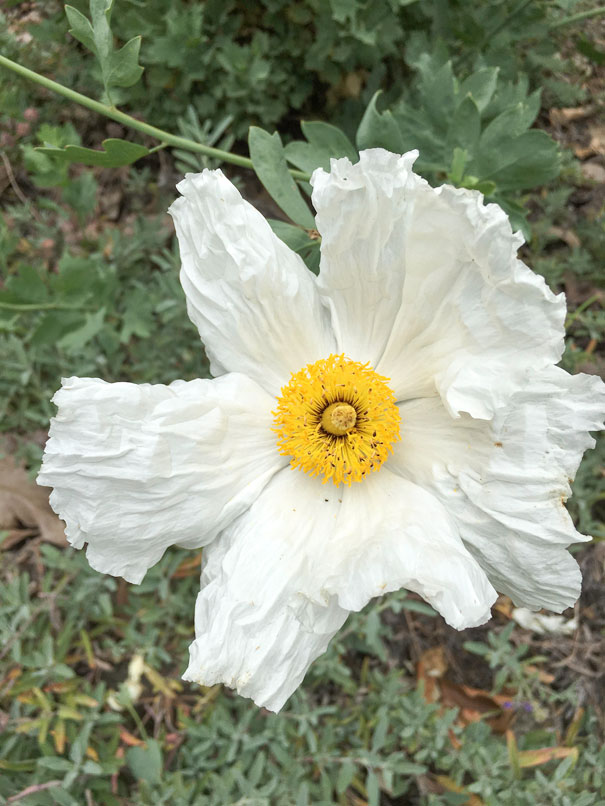Michelle Matthew (Executive Director of Arlington Garden) and Tahereh Sheerazie (Head Gardener)
Goodbye Friend
I’ve seen dead trees, but I haven’t seen a tree die before. In February, we noticed moderate dieback on the old coast live oak (Quercus agrifolia) along Arlington Drive during a visit from Mike Evans of Tree of Life Nursery. Concerned, we reached out to many local experts, including arborists and an entomologist and had soil testing done by Waypoint Analytical. Eventually, we found that the oak was weakened by drought stress, had been further weakened by various boring insects, and was overcome by the fungus Phytophthora cinnamomi (as determined by plant pathologist, Paul Santos) from which the tree would not recover. It was a hard decision, but eventually we sought permission to remove the oak from the City of Pasadena – permission is necessary because coast live oak is a locally protected species – and the tree was removed by arborists TreeCareLA on May 16.
 The smaller branches were mulched, but we kept the larger branches intact. Volunteers and staff wrapped them in plastic to kill any remaining borers (see image above). Angel City Lumber removed the trunk, and we will collaborate with the owner Jeff Perry to transform it into a ceremonial gathering table to be returned to the garden. If you would like to donate to the fabrication of the table, you will be able to do so as part of our upcoming summer fundraising campaign, which will launch in the middle of July.
The smaller branches were mulched, but we kept the larger branches intact. Volunteers and staff wrapped them in plastic to kill any remaining borers (see image above). Angel City Lumber removed the trunk, and we will collaborate with the owner Jeff Perry to transform it into a ceremonial gathering table to be returned to the garden. If you would like to donate to the fabrication of the table, you will be able to do so as part of our upcoming summer fundraising campaign, which will launch in the middle of July.
This old oak was the first tree that we have lost at Arlington that preexisted the garden. It was a sad and difficult decision, but we made sure to do so only after due diligence, exploration of all options, and only as the last resort.
For their professional expertise, we would like to thank the following: Richard McLeod, Bartlett Tree; Mike Evans, Tree of Life Nursery; Alison Lancaster Consulting Arborists LLC; Rebecca Latta Arborist; TreeCareLA; Dr. Christopher Shogren, UCANR Entomologist, Michael King, City of Pasadena; and Jeff Perry of Angel City Lumber.
Olive Allée and Northwest Garden
Over the past few months, we’ve worked with contractors to have other essential work done in the garden. Frank Locatell Masonry resurfaced the formal entrance and removed remnants of a vandalized bird bath. John Lynch of Arborvitate Tree Care removed dead trees, did structural pruning of the olives and mulberry tree, and removed a cypress in the way of power lines.
Although it is a popular landscaping plant for its bright color and “cool” look, we cleared a stand of sticks on fire (Euphorbia tirucalli) along the northwest side of the garden. The stand had gotten out of control, and sticks on fire don’t provide native pollinator habitat and have a toxic milky sap (“latex”) making them difficult to maintain. Phil and Sons did the hard work of removing them, and we will eventually replant the area with species of greater ecological value.
Effects of a Soggy Winter
During the wind and heavy rains in February, one of our cypress trees near the meadow toppled over. We have since reused its mulch in the garden, and removed a sister tree that was infested with bark beetles. With more sunlight streaming into the meadow area, the weed population has naturally exploded. In fact, weeds have been a particular challenge this year due to the additional moisture present in the soil. Our Tuesday and Weekend Workshop volunteers have been invaluable in helping keep the population under control. Although the rain has been a boon for most plants, especially our extremely prolific native roses, it has been the bane of others, including native sages, Matilija poppies, mallows, ceanothus, palo verde trees, and really anything that does not like constant moisture.
The desert garden took a hit with a deadly agave weevil infestation a couple years back; with the help of Outward Bound Adventures and Weekend Workshops, we have since cleared all the dead material and look forward to replanting this section with non-agave desert plants from closer to home, better suited to our increasingly arid climate, notwithstanding this year’s wet conditions! We planted a few desert shrubs in the spring in this area, and we are looking forward to Mike Evans of Tree of Life nursery helping us with the redesign.
Washington Navel Orange Grove
Due to all the rain, and the location of the citrus grove in the lowest part of the garden (there is a 30 foot elevation drop from top to bottom) many of the citrus trees sat in water for weeks. These were extremely difficult conditions for the trees, and we lost a few.
We had some soil tests that revealed that soil nitrogen was low, so we treated this area with a deep root and foliar spray applied by arborist Nick Mook. Additionally, we decided to cover-crop the grove with nitrogen-fixing species (like vetch) and added green manure. We look forward to a bountiful harvest this winter, so that we can make more of our delicious sweet orange marmalade. We estimate that we will sell out of our current stock later this year. If you are interested in learning more about citrus care, we are holding a “The Art of Citrus Care and Pruning” workshop on Saturday, July 1 with arborist Enjoli Ferrari. Workshop participants will learn a lot about citrus care while getting hands-on experience pruning citrus trees in our orange grove!





Recent Comments